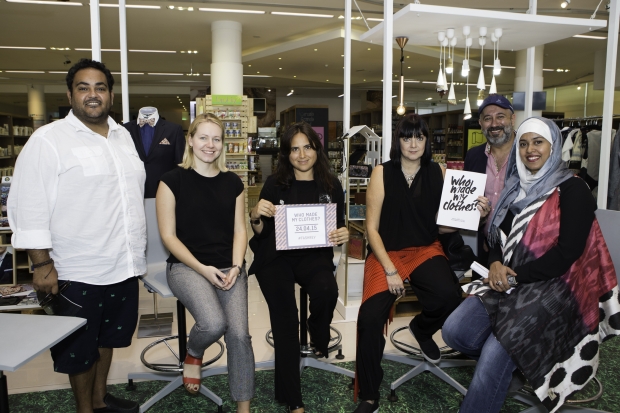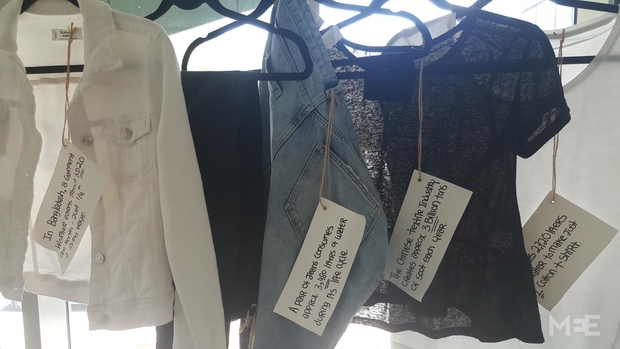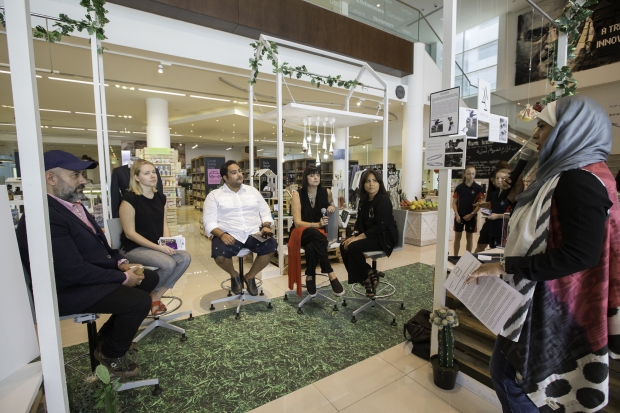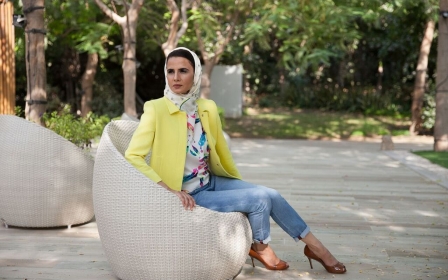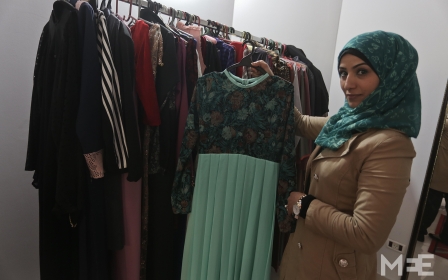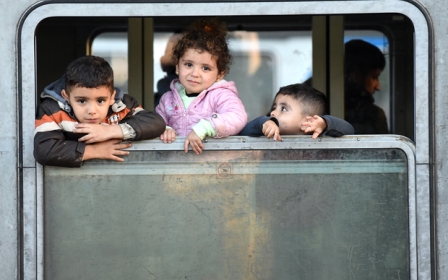A Fashion Revolution in the Middle East?

As the dust settles from a week of global fashion activism (18-24 April), there is an acknowledgment from all of the participants in Fashion Revolution that it has been a great start - yet there is still a very long way to go.
“Overall the industry has not changed very much. However, I am positive about the future,” says Sarah Ditty, editor-in-chief of Source magazine at the Ethical Fashion Forum.
Much remains unchanged in the billion-dollar industry and as the banners come down and tweets dissolve into an old timeline, it is evident that bringing ethical change to the fashion industry is going to be a long process. The rights of garment workers’ are continually undermined in an industry focused on capital gain, excess and beauty.
Set up in London in the wake of one of the largest industrial disasters in modern times - the Rana Plaza complex collapse in the Savar district of Bangladesh on 24 April 2013 - Fashion Revolution was established by ethical designers Orsola de Castro and Carry Somers to respond to some of the pressing issues facing garment workers.
It saw its first day of action on the Rana Plaza disaster anniversary in 2014. The participants aim to create sustainability in the fashion world by bringing to light its true costs. The brainchild of those working for a more ethical fashion industry, teams throughout the world coordinate projects to inspire, act and ask for change.
The collapse killed 1,134 garment workers who had stayed inside the complex as they continued to work in the factory it hosted. Though the building housed a garment factory, bank and various outlets, it was the garment workers who remained after they were forced to continue working despite the building having been evacuated by everyone else due to safety concerns. What for the past two years was a Fashion Revolution Day to commemorate the tragic anniversary, this year turned into a Fashion Revolution Week. A week of activities uniting designers, forums, bloggers, consumers and activists.
Ayesha Siddequa, a country coordinator for Fashion Revolution projects in the UAE, says the aims of Fashion Revolution in the Gulf States are to “bring about changes in home-grown fashion businesses.” Siddequa is currently busy setting things in motion for an event to be hosted in Dubai called “The Change Initiative.”
“We are working on spreading awareness also within schools and universities. We have tied up with two universities, Hariott Watt Dubai and Sharjah University of Fine Arts and Design, to work on sustainable fashion projects with many more projects in the pipeline,” said Siddequa.
The UAE is often associated with consumerism and excess, with a reputation of having little focus on workers’ rights. Only recently Amnesty International’s deputy director for the Middle East and North Africa, Said Boumedouha said: “The UAE authorities seem to be willing to stop at nothing to prevent people from speaking up about human rights,” following the refusal of entry to human rights advocates. But Siddequa says the UAE is “moving towards” better rights for workers. Although “they were neglected earlier,” the campaign is broadening in support, since joining the Revolution in 2015. “We definitely have had more people talk about the campaign and wanting to be a part of it.”
Three years into Fashion Revolution, 89 countries are taking part in the week of activism this year; a week which finds Swedish retail giant H&M host their own global ethical initiative "World Recyle Week".
“The awareness of these issues in this region is maybe 10 percent. So a lot of workshops, talks, collaborations are happening to build awareness. This region needs a few more years to catch up with the western world.” Siddequa added.
Joining Siddequa in the quest for a fashion revolution in the Middle East this year is Danah Almadani, Kuwait's country coordinator for Fashion Revolution. Almadani says she was introduced to Fashion Revolution by an ethical footwear and accessories designer who she met at a design course in Kuwait. Following her departure from the corporate world as a marketing manager in the food and beverage industry, Almadani had been teaching a fashion course. She herself has attended various short courses at the London College of Fashion and has explored the production process within the regional fashion industry, launching a sample collection of her own. Upon joining the Fashion Revolution team, Almadani understood she wanted to do more.
“I had realised that I wanted more than just a money-making job - I wanted to do good. I took it up as a personal challenge for myself, a step into the fashion industry, and a little way to make somewhat of a difference, a positive impact.” Almadani said.
The project this year is a first for Kuwait, but one Almadani and the team hope to continue. “Our main goal at the moment is to create awareness. With a high standard of living, and a fashion forward population, we tend to invest plenty in fashion - whether it is clothes, accessories, or makeup. Awareness, however, is lacking. Generally, people are unaware of the impact the fashion industry has on the environment and the people.”
With such little awareness of the aims and goals for Fashion Revolution, Almadani explains the tasks of the week.
“We set up an exhibition to be concluded with a screening of a documentary, showcasing some statistics about the impact of the fashion industry on the people and our planet. Generally, people were either surprised, or were aware and impressed to see Kuwait moving forward to stand for this issue,” she said.
Ditty, from the Ethical Fashion Forum, says the demand for more ethical fashion is growing as awareness increases.
“We do see that there is much more awareness amongst the public about the hidden social and environmental issues behind our clothing. I do feel that there is a growing demand for fashion that’s been made ethically and sustainably. It’s difficult to quantify, but if you look at the huge number of people getting involved in Fashion Revolution on social media, you can see the appetite for cleaner, safer, fairer fashion is there and growing,” Ditty said.
She is optimistic of the global change in attitude from the general public, noting as hugely significant the different countries that are getting on board with Fashion Revolution.
“In the Middle East, Fashion Revolution now has teams in Kuwait, Turkey and the United Arab Emirates, which is really exciting. Given that we’re now seeing Syrian refugees beginning to work in the cotton, textiles and garment industries in Turkey, the issue of human rights in fashion becomes even more salient,” she added.
In the UAE, the Fashion Revolution team says the project brought about excitement from both expats and locals, and was an initiative everyone could feel a part off. The “UAE has 90 percent expats. They are happy these changes are coming here, that they will find alternatives to fast fashion. The locals are excited about it too. The one thing that sells in this region is aesthetics,” Siddequa said.
The market in the UAE relies heavily on celebrity endorsements and one of the aims of the Fashion Revolution team has been to get these all important influencers on board. “We just signed up Sohad Acouri, a Lebanese UAE couture designer as Fashion Revolution UAE Brand Ambassador and we’re working on getting many more on board," she added.
With more countries joining every year, awareness of the exploitation that takes place in the garment industry has undoubtedly been raised thanks to the Fashion Revolution project.
Whether it is under the banner of Fashion Revolution or not, the days surrounding the anniversary of the Rana Plaza collapse have become a time for activism. Calls to change the fashion industry into a fair one for all have become both widespread and pronounced. Three years on from the Rana Plaza collapse there is far greater consciousness when it comes to our clothes, but it is certainly not yet enough.
Middle East Eye propose une couverture et une analyse indépendantes et incomparables du Moyen-Orient, de l’Afrique du Nord et d’autres régions du monde. Pour en savoir plus sur la reprise de ce contenu et les frais qui s’appliquent, veuillez remplir ce formulaire [en anglais]. Pour en savoir plus sur MEE, cliquez ici [en anglais].


